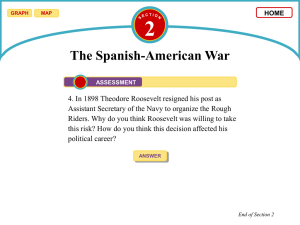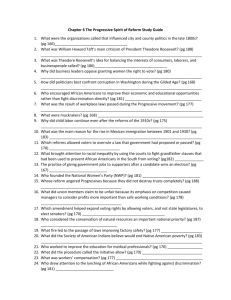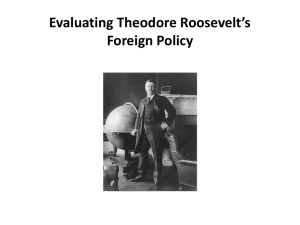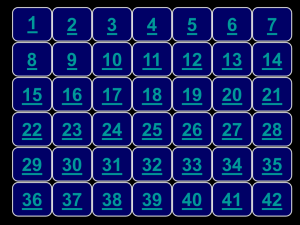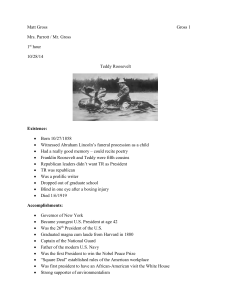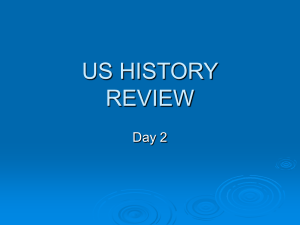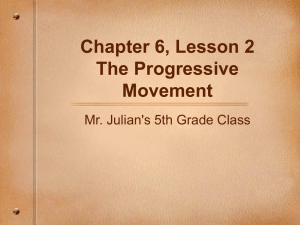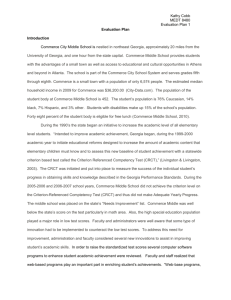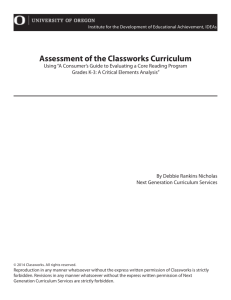1st grade 1.1215 lesson 17 Lesson Plans with Intergrated Sci and
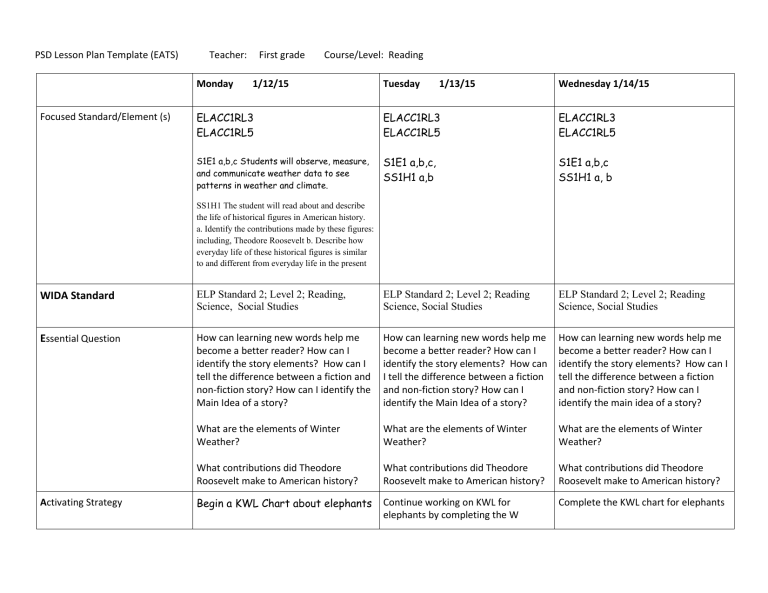
PSD Lesson Plan Template (EATS) Teacher: First grade Course/Level: Reading
Monday 1/12/15 Tuesday 1/13/15
Focused Standard/Element (s) ELACC1RL3
ELACC1RL5
S1E1 a,b,c Students will observe, measure, and communicate weather data to see patterns in weather and climate.
ELACC1RL3
ELACC1RL5
S1E1 a,b,c,
SS1H1 a,b
SS1H1 The student will read about and describe the life of historical figures in American history. a. Identify the contributions made by these figures: including, Theodore Roosevelt b. Describe how everyday life of these historical figures is similar to and different from everyday life in the present
WIDA Standard
E
ssential Question
Activating Strategy
Wednesday 1/14/15
ELACC1RL3
ELACC1RL5
S1E1 a,b,c
SS1H1 a, b
ELP Standard 2; Level 2; Reading,
Science, Social Studies
ELP Standard 2; Level 2; Reading
Science, Social Studies
ELP Standard 2; Level 2; Reading
Science, Social Studies
How can learning new words help me become a better reader? How can I identify the story elements? How can I tell the difference between a fiction and non-fiction story? How can I identify the
Main Idea of a story?
What are the elements of Winter
Weather?
What contributions did Theodore
Roosevelt make to American history?
How can learning new words help me become a better reader? How can I identify the story elements? How can
I tell the difference between a fiction and non-fiction story? How can I identify the Main Idea of a story?
What are the elements of Winter
Weather?
What contributions did Theodore
Roosevelt make to American history?
Begin a KWL Chart about elephants
Continue working on KWL for elephants by completing the W
How can learning new words help me become a better reader? How can I identify the story elements? How can I tell the difference between a fiction and non-fiction story? How can I identify the main idea of a story?
What are the elements of Winter
Weather?
What contributions did Theodore
Roosevelt make to American history?
Complete the KWL chart for elephants
Teaching
Opening (10-15 min)
Work-Time Activities (45-55 min)
Preview “Jungle Fun”, and discuss beginning, middle and ending of a story.
Take a Picture walk through “Can
Elephants Paint?”
Read aloud “Can Elephants Paint?”, question and check for understanding
Read “Can Elephants Paint”, Focus on details to check for comprehension of non-fiction stories
Introduce new sight words for the week by calling out clues and having the students to glue the words on a piece of paper, then illustrate.
We will use close passages and intergrate science and social studies to introduce robust vocabulary, and review previously taught reading skills: main idea, and details.
Science: Introduce closed reading
“ Snow Storms ”
.
Make a list of words students don ’ t know the meaning to and use context clues to figure the words out.
Social Studies: Introduce Theodore
Roosevelt to the class with a Brainpop video about his life. After the video discuss facts the students remember about him. Chart these. Read the close passage about him. Have the student to underline or highlight any vocabulary words they did not know.
Review fiction and non-fiction stories, make a list of characteristics that makes “Can Elephants Paint? “a nonfiction story.
We will use close passages and intergrate science and social studies to introduce robust vocabulary, and review previously taught reading skills: main idea, and details.
Close Reading - "Snow Storms" Take passage out and re-read it, review the vocabulary terms from previous day and complete vocabulary sheet, students circle words in the passage and go over it together
Social Studies: Review the Theodore
Roosevelt chart from yesterday’s lesson. Watch and discuss a youtube video: Theodore Roosevelt Biography for Kids, by Marudick 74 (6:18). This video is told by a student. (or a library book) Add any new facts the students learned from the book to the chart.
Reread and discuss the close passage.
Using the close passage. Identify and define 3 or 4 vocabulary words from the passage.
We will use close passages and intergrate science and social studies to introduce robust vocabulary, and review previously taught reading skills: main idea, and details.
Close Reading - "Snow Storms" Read the passage again as a whole group, complete the comprehension page by going through each question together and answering them while highlighting the evidence from the text to support each answer, high group may be able to discuss and complete within their group, keep redirecting toward the text to prove their answers
Social Studies: Review the Theodore
Roosevelt chart from yesterday’s lesson. Watch and discuss a youtube video Theodore Roosevelt Fun Facts, by Carlyducey (4:16) (or a library book) Add any new facts the students learned from the book to the chart.
Students will use the graphic organizer to write 6 details about him.
Differentiation Offered
Summarizing
Closure Activity (20-30 min)
Focused Standard/Element (s)
WIDA Standard
All Lessons Monday are Whole Group for
Introduction
Story Elements: Main Idea below: draw and label the main idea of “Jungle Fun”/Do this Alone to use
For Assessment
On level: Complete Main Idea Level
1/Do this Alone to use for assessment
Above: Main Idea Lesson on
Classworks/Starfall (Use Classworks for Assessment)
Focus: Main Idea of leveled readers below: draw and label the main idea on construction paper, read leveled readers, put sight words in correct sentence (Main Idea Exit slip for
Assessment) on level: Main Idea Lesson on
Classworks/Starfall (Use Classworks for
Assessment) above: Main Idea level 2, put sight words in correct sentence(Main Idea
Exit Slip for Assessment)
Journaling: What other animal do you think could paint? Why?
Journaling: Why do you think elephants are so big?
Exit Slip: Comprehension of story elements (Use for differentiation groups)
Thursday 1/15/15
ELACC1RL3
ELACC1RL5
S1E1a,b,c
SS1H1 a, b
Friday 1/16/15
ELACC1RL3
ELACC1RL5
S1E1a,b,c
SS1H1 a, b
Additional Notes
ELP Standard 2; Level 2; Reading,
Science, Social Studies
ELP Standard 2; Level 2; Reading,
Science, Social Studies
Essential Question
Activating Strategy
How can learning new words help me become a better reader? How can I identify the story elements? How can I tell the difference between a fiction and non-fiction story? How can I identify the main idea of a story?
What are the elements of Winter
Weather?
What contributions did Theodore
Roosevelt make to American history?
How can learning new words help me become a better reader? How can I identify the story elements? How can
I tell the difference between a fiction and non-fiction story? How can I identify the Main Idea of a story?
What are the elements of Winter
Weather?
What contributions did Theodore
Roosevelt make to American history?
Create a post card pretending like you are visiting the painting elephants. Tell all about them.
Review words – play “Sparkle”;
Listen to “Can Elephants Paint?” on cd Listen to story on CD Teaching
Opening (10-15 min)
Work-Time Activities (45-55 min) Review all words for the week complete sight word sentences for daily grade.
We will use close passages and intergrate science and social studies to introduce robust vocabulary, and review previously taught reading skills: main idea, and details.
Read a snowman or snow book and have the students write a story. Students will complete a Winter Words page.
Students can use their Winter Words page to write a winter story. Students
Take reading and language arts tests.
We will use close passages for science and social studies to introduce robust vocabulary, and review previously taught reading skills: main idea, and details.
Read a snowman or snow book.
Students will complete "My
Snowman" page and use the scrambled sentence at the bottom of the page as their main idea and write a story about their snowman.
Students can then share it with the class.
can illustrate their story and then share it with the class.
Social Studies: Review the chart from yesterday’s lesson. Reread and discuss the close passage. Answer the comprehension questions in the packet.
Social Studies: Review the Theodore
Roosevelt chart. Divide students into groups. Each group should meet and discuss Theodore Roosevelt. Each member of the group should write a different fact about his life on a sentence strip to present to the class.
Differentiation Offered
Summarizing
Closure Activity (20-30 min)
Read aloud a picture book of your choice then have the leveled groups to complete: below: Main Idea Lesson on
Classworks/Starfall (Use Classworks for
Assessment)
On level: Complete Main Idea Level 1 alone (Use for Assessment)
Above: Complete Main Idea Level 2 alone (Use for Assessment)
Exit Slip: Check for Understanding of
“Can Elephants Paint?” (fiction)
Author’s chair-choose a few students to share a journal writing from the week.
